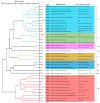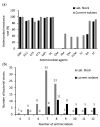Genetic Characterization, Antibiotic Resistance, and Virulence Genes Profiling of Bacillus cereus Strains from Various Foods in Japan
- PMID: 39200074
- PMCID: PMC11351997
- DOI: 10.3390/antibiotics13080774
Genetic Characterization, Antibiotic Resistance, and Virulence Genes Profiling of Bacillus cereus Strains from Various Foods in Japan
Abstract
Bacillus cereus sensu stricto is a foodborne pathogen that causes food poisoning. Their spore and biofilm-forming abilities persist in various environments and foods. This study investigated the prevalence, virulence, antibiotic resistance, and genetic diversity of B. cereus s. s. strains isolated from various food samples. Of 179 samples, 22.34% were positive for B. cereus s. s., with significantly high detection rates in milk products and raw chicken meat. Forty strains were isolated from positive samples. Matrix-assisted laser desorption ionization/time of flight mass spectrometry analysis revealed nine distinct clusters and multi-locus sequence typing revealed 34 sequence types including 23 novel sequences, demonstrating high genetic diversity among the isolates. PCR analysis revealed that all the strains contained at least one toxin gene, but none contained the cytK gene. Antibiotic resistance tests revealed that all isolates were classified as multidrug-resistant, with high resistance levels, particularly to β-lactam antibiotics and vancomycin, but were susceptible to gentamicin. All isolates showed variations in biofilm formation. This study highlights the significant public health risk due to B. cereus s. s. and underscores the need for stringent monitoring and control measures in food production to manage antimicrobial resistance and ensure food safety.
Keywords: Bacillus cereus sensu stricto; MALDI-TOF MS; multi-locus sequence typing analysis; multidrug resistance; β-lactam antibiotics.
Conflict of interest statement
The authors declare no conflicts of interest.
Figures



Similar articles
-
Prevalence, virulence factor genes and antibiotic resistance of Bacillus cereus sensu lato isolated from dairy farms and traditional dairy products.BMC Microbiol. 2017 Mar 14;17(1):65. doi: 10.1186/s12866-017-0975-9. BMC Microbiol. 2017. PMID: 28288581 Free PMC article.
-
Identification of Enterococcus spp. from food sources by matrix-assisted laser desorption ionization-time of flight mass spectrometry and characterization of virulence factors, antibiotic resistance, and biofilm formation.Int J Food Microbiol. 2024 Aug 2;420:110768. doi: 10.1016/j.ijfoodmicro.2024.110768. Epub 2024 May 31. Int J Food Microbiol. 2024. PMID: 38843647
-
Prevalence and Characteristics of Bacillus cereus Group Isolated from Raw and Pasteurised Milk.Curr Microbiol. 2020 Oct;77(10):3065-3075. doi: 10.1007/s00284-020-02129-6. Epub 2020 Jul 21. Curr Microbiol. 2020. PMID: 32696237
-
Prevalence, Virulence Genes, Antimicrobial Susceptibility, and Genetic Diversity of Bacillus cereus Isolated From Pasteurized Milk in China.Front Microbiol. 2018 Mar 26;9:533. doi: 10.3389/fmicb.2018.00533. eCollection 2018. Front Microbiol. 2018. PMID: 29632521 Free PMC article.
-
Characterization of the Bacillus cereus Group Isolated from Ready-to-Eat Foods in Poland by Whole-Genome Sequencing.Foods. 2024 Oct 14;13(20):3266. doi: 10.3390/foods13203266. Foods. 2024. PMID: 39456328 Free PMC article.
Cited by
-
Virulence potential of Bacillus cereus sensu lato group bacteria isolated from green leafy vegetables.Folia Microbiol (Praha). 2025 May 28. doi: 10.1007/s12223-025-01275-3. Online ahead of print. Folia Microbiol (Praha). 2025. PMID: 40434623
References
-
- Naas H., Zurghani M., Garbaj A., Azwai S., Eshamah H., Gammoudi F., Abolghait S., Moawad A., Barbieri I., Eldaghayes I. Bacillus cereus as an Emerging Public Health Concern in Libya: Isolation and Antibiogram from Food of Animal Origin. Libyan J. Med. Sci. 2018;2:56. doi: 10.4103/ljms.ljms_5_18. - DOI
LinkOut - more resources
Full Text Sources
Molecular Biology Databases
Research Materials

